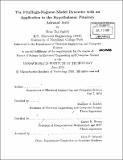| dc.contributor.advisor | Munther A. Dahleh and Emery N. Brown. | en_US |
| dc.contributor.author | Faghih, Rose Taj | en_US |
| dc.contributor.other | Massachusetts Institute of Technology. Dept. of Electrical Engineering and Computer Science. | en_US |
| dc.date.accessioned | 2010-12-06T17:31:43Z | |
| dc.date.available | 2010-12-06T17:31:43Z | |
| dc.date.copyright | 2010 | en_US |
| dc.date.issued | 2010 | en_US |
| dc.identifier.uri | http://hdl.handle.net/1721.1/60161 | |
| dc.description | Thesis (S.M.)--Massachusetts Institute of Technology, Dept. of Electrical Engineering and Computer Science, 2010. | en_US |
| dc.description | Includes bibliographical references (p. 68-70). | en_US |
| dc.description.abstract | In this thesis, I revisit the issue of the utility of the FitzHugh-Nagumo (FHN) model for capturing neuron firing behaviors. It has been noted (e.g., see [8]) that the FHN model cannot exhibit certain interesting firing behaviors such as bursting. I will illustrate that, by allowing time-varying parameters for the FHN model, one could overcome such limitations while still retaining the low order complexity of the FHN model. I also highlight the utility of the FHN model from an estimation perspective by presenting a novel parameter estimation method that exploits the multiple time scale feature of the FHN model, and compare the performance of this method with the Extended Kalman Filter through illustrative examples. Then, I apply this proposed extension to the FHN model to model cortisol secretion, which is controlled by the hypothalamic pituitary adrenal axis (HPA). Existing mathematical models for cortisol secretion do not include the entire cortisol secretion process, from the neural firing of cortopin releasing hormone(CRH) in the hypothalamus to cortisol secretion in a deterministic manner. I lay the groundwork to construct a more comprehensive model, relating CRH, Adrenocorticotropic hormone (ACTH), and cortisol. I start with one of the existing cortisol mathematical models, and add to it a simplified neural firing model to describe the CRH and ACTH release. This simplified neural firing model is obtained using the FHN model with time-varying spiking threshold. Moreover, I include a feedback in this model and model the cortisol secretion as a tracking problem. | en_US |
| dc.description.statementofresponsibility | by Rose Taj Faghih. | en_US |
| dc.format.extent | 70 p. | en_US |
| dc.language.iso | eng | en_US |
| dc.publisher | Massachusetts Institute of Technology | en_US |
| dc.rights | M.I.T. theses are protected by
copyright. They may be viewed from this source for any purpose, but
reproduction or distribution in any format is prohibited without written
permission. See provided URL for inquiries about permission. | en_US |
| dc.rights.uri | http://dspace.mit.edu/handle/1721.1/7582 | en_US |
| dc.subject | Electrical Engineering and Computer Science. | en_US |
| dc.title | The FitzHugh-Nagumo model dynamics with an application to the hypothalamic pituitary adrenal axis | en_US |
| dc.title.alternative | FHN model dynamics with an application to the HPA | en_US |
| dc.type | Thesis | en_US |
| dc.description.degree | S.M. | en_US |
| dc.contributor.department | Massachusetts Institute of Technology. Department of Electrical Engineering and Computer Science | |
| dc.identifier.oclc | 681753806 | en_US |
